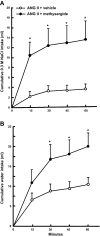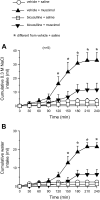Role of the lateral parabrachial nucleus in the control of sodium appetite
- PMID: 24401989
- PMCID: PMC3921312
- DOI: 10.1152/ajpregu.00251.2012
Role of the lateral parabrachial nucleus in the control of sodium appetite
Abstract
In states of sodium deficiency many animals seek and consume salty solutions to restore body fluid homeostasis. These behaviors reflect the presence of sodium appetite that is a manifestation of a pattern of central nervous system (CNS) activity with facilitatory and inhibitory components that are affected by several neurohumoral factors. The primary focus of this review is on one structure in this central system, the lateral parabrachial nucleus (LPBN). However, before turning to a more detailed discussion of the LPBN, a brief overview of body fluid balance-related body-to-brain signaling and the identification of the primary CNS structures and humoral factors involved in the control of sodium appetite is necessary. Angiotensin II, mineralocorticoids, and extracellular osmotic changes act on forebrain areas to facilitate sodium appetite and thirst. In the hindbrain, the LPBN functions as a key integrative node with an ascending output that exerts inhibitory influences on forebrain regions. A nonspecific or general deactivation of LPBN-associated inhibition by GABA or opioid agonists produces NaCl intake in euhydrated rats without any other treatment. Selective LPBN manipulation of other neurotransmitter systems [e.g., serotonin, cholecystokinin (CCK), corticotrophin-releasing factor (CRF), glutamate, ATP, or norepinephrine] greatly enhances NaCl intake when accompanied by additional treatments that induce either thirst or sodium appetite. The LPBN interacts with key forebrain areas that include the subfornical organ and central amygdala to determine sodium intake. To summarize, a model of LPBN inhibitory actions on forebrain facilitatory components for the control of sodium appetite is presented in this review.
Keywords: angiotensin; electrolyte balance; sodium intake; thirst.
Figures




Similar articles
-
Importance of the central nucleus of the amygdala on sodium intake caused by deactivation of lateral parabrachial nucleus.Brain Res. 2015 Nov 2;1625:238-45. doi: 10.1016/j.brainres.2015.08.044. Epub 2015 Sep 7. Brain Res. 2015. PMID: 26358148
-
Cholecystokinin actions in the parabrachial nucleus: effects on thirst and salt appetite.Am J Physiol. 1998 Nov;275(5 Pt 2):R1431-7. doi: 10.1152/ajpregu.1998.275.5.r1431. Am J Physiol. 1998. PMID: 9791058
-
Lateral parabrachial nucleus and opioid mechanisms of the central nucleus of the amygdala in the control of sodium intake.Behav Brain Res. 2017 Jan 1;316:11-17. doi: 10.1016/j.bbr.2016.08.035. Epub 2016 Aug 17. Behav Brain Res. 2017. PMID: 27544874
-
The neuroendocrinology of thirst and salt appetite: visceral sensory signals and mechanisms of central integration.Front Neuroendocrinol. 1997 Jul;18(3):292-353. doi: 10.1006/frne.1997.0153. Front Neuroendocrinol. 1997. PMID: 9237080 Review.
-
Neurochemical Circuits Subserving Fluid Balance and Baroreflex: A Role for Serotonin, Oxytocin, and Gonadal Steroids.In: De Luca LA Jr, Menani JV, Johnson AK, editors. Neurobiology of Body Fluid Homeostasis: Transduction and Integration. Boca Raton (FL): CRC Press/Taylor & Francis; 2014. Chapter 9. In: De Luca LA Jr, Menani JV, Johnson AK, editors. Neurobiology of Body Fluid Homeostasis: Transduction and Integration. Boca Raton (FL): CRC Press/Taylor & Francis; 2014. Chapter 9. PMID: 24829993 Free Books & Documents. Review.
Cited by
-
Endogenous central amygdala mu-opioid receptor signaling promotes sodium appetite in mice.Proc Natl Acad Sci U S A. 2016 Nov 29;113(48):13893-13898. doi: 10.1073/pnas.1616664113. Epub 2016 Nov 14. Proc Natl Acad Sci U S A. 2016. PMID: 27849613 Free PMC article.
-
Oxytocin-receptor-expressing neurons in the parabrachial nucleus regulate fluid intake.Nat Neurosci. 2017 Dec;20(12):1722-1733. doi: 10.1038/s41593-017-0014-z. Epub 2017 Nov 13. Nat Neurosci. 2017. PMID: 29184212 Free PMC article.
-
Central regulation of body fluid homeostasis.Proc Jpn Acad Ser B Phys Biol Sci. 2022;98(7):283-324. doi: 10.2183/pjab.98.016. Proc Jpn Acad Ser B Phys Biol Sci. 2022. PMID: 35908954 Free PMC article. Review.
-
Sodium Homeostasis, a Balance Necessary for Life.Nutrients. 2023 Jan 12;15(2):395. doi: 10.3390/nu15020395. Nutrients. 2023. PMID: 36678265 Free PMC article. Review.
-
Inhibition of salty taste and sodium appetite by estrogens in spontaneously hypertensive rats.Front Physiol. 2023 May 22;14:1163568. doi: 10.3389/fphys.2023.1163568. eCollection 2023. Front Physiol. 2023. PMID: 37284542 Free PMC article. Review.
References
-
- Almeida RL, David RB, Constancio J, Fracasso JF, Menani JV, DeLucaJr LA. Inhibition of sodium appetite by lipopolysaccharide: involvement of α2-adrenoceptors. Am J Physiol Regul Integr Comp Physiol 301: R185–R192, 2011 - PubMed
-
- Andrade CAF, Barbosa SP, De Luca LA, Jr, Menani JV. Activation of α2-adrenergic receptors into the lateral parabrachial nucleus enhances NaCl intake in rats. Neuroscience 129: 25–34, 2004 - PubMed
-
- Andrade-Franzé GM, Andrade CA, De Luca LA, Jr, De Paula PM, Colombari DS, Menani JV. Lesions in the central amygdala impair sodium intake induced by the blockade of the lateral parabrachial nucleus. Brain Res 1332: 57–64, 2010 - PubMed
-
- Andrade-Franzé GM, Andrade CA, De Luca LA, Jr, De Paula PM, Menani JV. Lateral parabrachial nucleus and central amygdala in the control of sodium intake. Neuroscience 165: 633–641, 2010 - PubMed
-
- Antunes-Rodrigues J, De Castro M, Elias LK, Valença MM, McCann SM. Neuroendocrine control of body fluid metabolism. Physiol Rev 84: 169–208, 2004 - PubMed
Publication types
MeSH terms
Substances
Grants and funding
LinkOut - more resources
Full Text Sources
Other Literature Sources
Medical

